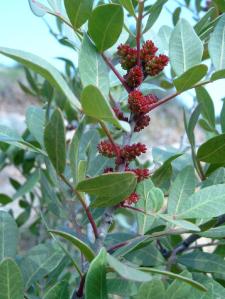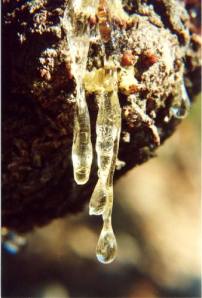
Pistacia lentiscus in flower
I had wanted to write this article on mastic gum as an effective treatment for Helicobacter pylori for some time now, but it was Dr. OZ’s Christmas Eve show that finally did it. When a friend who knew that I had healed myself of H. pylori reported that this and ulcers were the topic of today’s Dr. OZ Show, I was all ears. I was glad the show was helping the general public to make the connection between ulcers and H. pylori, as this has long been overlooked. Regardless, doctors rarely recommend one of the easy tests that detect H. pylori to patients presenting with ulcer symptoms. While kefir was mentioned for these symptoms, most of the folks on the show had never heard of kefir. And while this helps to increase awareness of the importance and necessity for probiotics, kefir doesn’t cure H. pylori.[1] It was when I heard the final recommendation for H. pylori was antibiotics, however, that I knew I couldn’t put off writing this article any longer.
Let me start by sharing my own story. For years I had this on and off again burning in the pit of my stomach. It was worse at night and felt like a gnawing hunger that might feel better if I ate something to help coat or soothe my stomach, but eating made no difference. After a while, I surmised that I must have an ulcer. I tried digestive enzymes but that didn’t work. Then I tried antacids and H2 blockers, which are completely against my belief system of treating symptoms and not the cause, and they made no difference whatsoever. I did notice, however, that eliminating sugar helped.

Mastic gum resin
Then I had a recurrent mold exposure that launched a raging sinus infection. My eyes swelled shut. Yellow puss oozed from them, and my throat swelled to where I could hardly swallow. I feared not being able to breathe. So, I immediately went to the doctor. Neither he nor I wanted for me to go to the hospital. So he prescribed not penicillin but “gorilla-cillin,” a powerful antibiotic combination without ever diagnosing the specific pathogen culprit. After this round of antibiotics, my sinus infection got better, but the “ulcer” got significantly worse. I started having pressure in my esophagus. I went back to another doctor, a gastroenterologist. She recommended an endoscopy, but I declined in favor of doing additional research on my own. This doctor suggested that I might have an ulcer as well as an overgrowth of candida in my esophagus. I did not want to undergo an invasive test, but I needed to know what created that much havoc in my body. My research revealed information connecting ulcers to H. pylori infection, which the doctor neglected to mention. I also learned that statistically, up to 90% of duodenal ulcers might be caused by a Helicobacter pylori (H. pylori) infection. Medical science had previously assumed that stress, spicy food, or excess stomach acid caused ulcers.
So I went back to the doctor for my yearly exam and requested a blood test for the H. pylori bacterium. Several non-invasive tests exist for evaluating the presence of the bacteria, including blood, saliva, stool, or a breath test. However, the most reliable method is a biopsy check during endoscopy. I opted for the blood test.
At least half the world’s population is infected with H. pylori making it the most widespread infection. And while contagious, the exact route of transmission is not known. Findings suggest that it is more easily transmitted via gastric mucus than via saliva. It may also be transmitted via contaminated well water, soil, or from food harvested in fields where workers defecate. It is also very possible that houseflies act as a viable source of spread since they frequently come into contact with human food and fecal matter.
When I returned to the doctor’s office for my blood results, I sat in the waiting room for almost an hour before being brought into an exam room. I was left there alone for another hour before the doctor finally arrived. During that time in the exam room, I noticed a small paperback reminiscent of a Readers Digest on the counter next to the sink. It contained articles on the latest drug recommendations for various conditions, and I busied myself reading it. I was surprised when I turned to an article on H. pylori and the recommended antibiotic cocktail for curing it. H. pylori is a growing concern in the pharmacological literature.
The doctor finally arrived and apologized for being late. She had been going over the results of my blood work. She happily announced that everything looked normal: blood sugar, cholesterol, thyroid, white and red blood cell count, etc. I had to ask her, “what about the H. pylori?” She had completely overlooked it and had to scramble through her paperwork to find the results. “Oh!” she said, quite flustered, “You are positive for H. pylori!” Obviously, she had not spent the last hour looking over the result of my blood work. I flashed the article on H. pylori from her magazine that I found in her exam room and told her she might want to read up. She then prescribed the routine antibiotic cocktail, which included Flagyl (an antibiotic drug also used to treat Candida with serious possible side effects[2]). Since I had good insurance, I filled the prescription and carried a grocery bag full of drugs that included antibiotics and a proton pump inhibitor home with me.
I sat contemplating this turn of events. The fact that a round of antibiotics had put my “ulcer” symptoms over the top in the first place and caused what I felt to be an overgrowth of H. pylori, just like they can cause an overgrowth of Candida, I could not bring myself to take them. In addition, an increasing number of infected individuals harbor antibiotic-resistant bacteria and report a high treatment failure rate (up to 20%) requiring additional rounds of antibiotic therapy, which further discouraged me. It made sense that I had noticed a reduction of symptoms by eliminating sugar since perhaps sugar feeds H. pylori, just like it does Candida. Then, I started a timeline of my symptoms and realized that they had started after a round of antibiotics for an earlier sinus infection, also from mold exposure. Further research showed that H. pylori is a member of the normal flora, which helps to regulate stomach acidity. When symptoms accompany an overgrowth, that is when it becomes a problem. Common sense told me to avoid antibiotics.
 It seemed clear that I needed to bring the H. pylori under control, but not only did I not want to take the antibiotics, I was also downright afraid of taking them. So I went back to the computer to look for alternatives to antibiotics. What I found was mastic gum. And not surprisingly as I have a lot of faith in plant medicine.
It seemed clear that I needed to bring the H. pylori under control, but not only did I not want to take the antibiotics, I was also downright afraid of taking them. So I went back to the computer to look for alternatives to antibiotics. What I found was mastic gum. And not surprisingly as I have a lot of faith in plant medicine.
 Mastic gum is a tree resin produced by an evergreen shrub from the pistachio tree family, Pistacia lentiscus. The tree hails from the Greek island of Chios, and the resin is known as “Chios tears” because once the bark is slit, it trickles out slowly creating crystal-like “tears.” In some shops, it is called “Arabic gum,” not to be confused with gum arabic. The word mastic is a synonym for gum in many languages and is derived from the Greek verb, “to gnash the teeth,” which is the source of the English word, masticate. Greeks have been chewing on these resin granules for centuries, consumed to freshen the breath, cut down on bacteria in the mouth, and remove dental plaque. Ground, it is used in a variety of baked goods for its rich aroma and licorice-like flavor. Used since antiquity as a medicine and in the Middle East for at least 3,000 years, mastic is still being used in the traditional folk medicine of the Middle East for gastric ailments.
Mastic gum is a tree resin produced by an evergreen shrub from the pistachio tree family, Pistacia lentiscus. The tree hails from the Greek island of Chios, and the resin is known as “Chios tears” because once the bark is slit, it trickles out slowly creating crystal-like “tears.” In some shops, it is called “Arabic gum,” not to be confused with gum arabic. The word mastic is a synonym for gum in many languages and is derived from the Greek verb, “to gnash the teeth,” which is the source of the English word, masticate. Greeks have been chewing on these resin granules for centuries, consumed to freshen the breath, cut down on bacteria in the mouth, and remove dental plaque. Ground, it is used in a variety of baked goods for its rich aroma and licorice-like flavor. Used since antiquity as a medicine and in the Middle East for at least 3,000 years, mastic is still being used in the traditional folk medicine of the Middle East for gastric ailments.
One of my herbal mentors, Patricia Kyritsi Howell, goes to Greece every year and affirmed the power of this medicine for healing gastric complaints. Production is controlled by a co-operative of medieval village in the south of Chios and granted protected designation of origin. Traditionally there has been limited production of mastic, further threatened by the Chios forest fire that swept the southern half of the island in August 2012 and destroyed many of the mastic groves. During the Ottoman rule of Chios, mastic was worth its weight in gold. I would argue that it still is. The benefit of this “tree-medicine,” as I like to call it, is now being rediscovered for its antimicrobial effects. The most exciting of these discoveries is its effectiveness against at least seven different strains of H. pylori with no side effects.

Chios, Greece
H. pylori are spiral-shaped bacteria that live in the mucosal lining of the stomach. The genus name, Helicobacter, is derived from the ancient Greek “spiral” or “coil”. Pylori means “of the pylorus” or pyloric valve, a circular opening leading from the stomach into the duodenum and is from an ancient Greek word meaning “gatekeeper.”
Mastic gum works by making changes within the bacteria’s cell structure, causing it to weaken and die. An article published by the New England Journal of Medicine titled “Mastic Gum Kills Helicobacter pylori” suggested that even low doses of mastic gum can cure peptic ulcers very rapidly. In several studies using mastic gum on ulcer patients, the original site of the ulcer caused by the bacterium was completely replaced by healthy epithelial cells.
The protocol that I have found to be the most effective is to start out slowly and increase the amount taken over a three-week period as follows:
Mastic Gum Extract, 500 mg. capsules,
Week 1: take 2 in the morning on an empty stomach one hour before breakfast for one week.
Week 2: Up the dosage to 4 per day, adding 2 in the afternoon on an empty stomach.
Week 3: Up the dosage to 6 for a total of 3 grams per day, adding 2 in the evening on an empty stomach (2 hrs. after dinner, one hour before bed.)
Die-off can cause nausea, so back off on the dosage if you start to feel nauseous. If needed, you can do a second round of the protocol. You may want to retest via a stool sample after a month or so. A blood test will not be accurate because of the antibodies. Be sure to add a good probiotic to your regimen following treatment.
 I have used this protocol to heal myself of H. pylori and in my clinical practice very successfully. One client shared it with her doctor after the stool sample returned negative. That is why we need herbalists with their “feet on the ground,” so to speak, and working first hand with the plant medicines. We cannot always depend on clinical trials funded by pharmaceutical companies or doctors knowledge whose education is also funded by pharmaceutical companies. The more of us who share our herbal knowledge, the more we will learn how to alleviate suffering and hopefully bring enough attention to alternative medicine to get the research funded that is so badly needed. It is in this spirit that I share my experience with the tree medicine of mastic gum. I can also attest that the results are long-lasting as it has been over ten years since curing my H. pylori. My yearly physical exam was last month, and I am happy to announce that the blood work (I had to specifically request a test for H. pylori) came back negative for the bacterium. And so it is.
I have used this protocol to heal myself of H. pylori and in my clinical practice very successfully. One client shared it with her doctor after the stool sample returned negative. That is why we need herbalists with their “feet on the ground,” so to speak, and working first hand with the plant medicines. We cannot always depend on clinical trials funded by pharmaceutical companies or doctors knowledge whose education is also funded by pharmaceutical companies. The more of us who share our herbal knowledge, the more we will learn how to alleviate suffering and hopefully bring enough attention to alternative medicine to get the research funded that is so badly needed. It is in this spirit that I share my experience with the tree medicine of mastic gum. I can also attest that the results are long-lasting as it has been over ten years since curing my H. pylori. My yearly physical exam was last month, and I am happy to announce that the blood work (I had to specifically request a test for H. pylori) came back negative for the bacterium. And so it is.
References:
1. Wang KY, Li SN, Liu CS et al. (September 2004). “Effects of ingesting Lactobacillus- and Bifidobacterium-containing yogurt in subjects with colonized Helicobacter pylori“. The American Journal of Clinical Nutrition 80 (3): 737–41.
2. Pounder RE, Ng D (1995). “The prevalence of Helicobacter pylori infection in different countries”. Aliment. Pharmacol. Ther. 9 (Suppl 2): 33–9.
3. Cave DR (May 1996). “Transmission and epidemiology of Helicobacter pylori“. Am. J. Med. 100 (5A): 12S–17S; discussion 17S–18S
4 Brown LM (2000). “Helicobacter pylori: epidemiology and routes of transmission”. Epidemiol Rev 22 (2): 283–97.
5 Blaser MJ (February 2005). “An endangered species in the stomach”. Sci. Am. 292 (2): 38–45. doi:10.1038/scientificamerican0205-38
6. Al-Said MS, Ageel AM, Parmar NS, Tariq M. Evaluation of mastic, a crude drug obtained from Pistacia lentiscus for gastric and duodenal anti-ulcer activity. J Ethnopharmacol 1986;15:271-8.
[1] An article in the American Journal of Clinical Nutrition found evidence that “ingesting lactic acid bacteria exerts a suppressive effect on Helicobacter pylori infection in both animals and humans,” noting that “supplementing with Lactobacillus and Bifidobacterium containing yogurt was shown to improve the rates of eradication of H. pylori in humans. (see reference below)
[2] Metronidazole crosses the placental barrier and enters fetal circulation rapidly. It is prescribed during pregnancy for the vaginal infection, trichomoniasis. Metronidazole is a carcinogen and may cause serious central and peripheral nervous system side effects such as: convulsive seizures, meningitis, and optic neuropathy.






